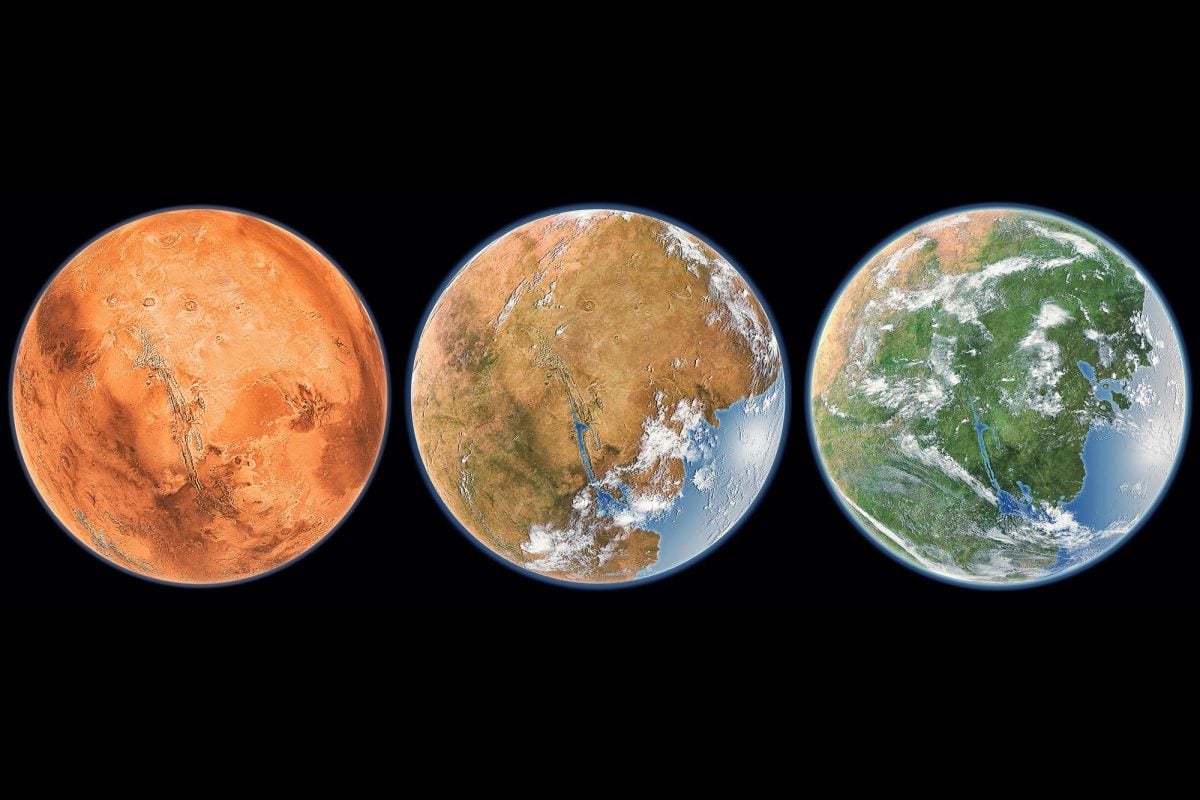Terraforming Mars: Dream, Delusion, or the Next Frontier?

The Outer Planet’s Allure
For centuries, outer space has fascinated humans for exploration, and the allure of what could have been has lingered in the minds of those who wished to go beyond Earth. One of such wonders is Mars — more than a distant red dot in the night sky, it has served as humanity’s mirror for ambition, fear, and possibility. From ancient astronomers mapping its orbit to sci-fi writers painting vivid tales of Martian civilizations, the planet has occupied the collective imagination of brilliant minds.

But today, the question has evolved beyond fiction: Can we actually turn Mars into a second Earth?
The idea of terraforming — transforming an alien world into one suitable for human life — sounds like something out of a blockbuster movie. Yet, serious scientists, engineers, and space visionaries like Elon Musk and NASA researchers are taking the idea seriously. Terraforming Mars isn’t just about survival; it’s about ensuring the continuity of human civilization beyond Earth, with justifications for choosing Mars over other potential terraforming targets, including the presence of water and a geological history that suggests it once harbored a dense atmosphere similar to Earth's.
But between scientific feasibility and moral responsibility, if this newfound quest becomes possible, lies a difficult question: Is terraforming Mars a dream worth chasing — or a delusion that distracts from fixing Earth itself?
The Science Behind Terraforming Mars
Terraforming, in the most simplest basis, involves modifying a planet’s atmosphere, temperature, and ecology to make it habitable. For Mars, the process would mean warming the planet and thickening its atmosphere to support liquid water and human life.
At present, Mars is a frozen desert. The average surface temperature is around –65°C, its atmosphere is 95% carbon dioxide, and its air pressure is less than 1% of Earth’s, meaning your blood would boil if you stepped outside without a suit.
To make Mars livable, scientists have proposed three main strategies:
Releasing Greenhouse Gases
The first step would be to trap heat. By releasing CO₂ and other greenhouse gases trapped in the planet’s polar ice caps and soil, scientists could thicken the atmosphere and raise temperatures. However, a 2018 study published in Nature Astronomy found that even if all CO₂ on Mars were released, it would only increase pressure to 1.2% of Earth’s level—far too low to sustain life.
Importing Ammonia or Methane
Another approach suggests importing gases like ammonia (from asteroids or moons) to accelerate the greenhouse effect. Yet, this would require moving celestial bodies across millions of kilometers, a task beyond current technology.
Deploying Orbital Mirrors
Some engineers propose deploying giant mirrors in orbit to reflect sunlight onto the Martian poles, gradually melting ice and releasing trapped gases. While conceptually possible, this would demand mirrors spanning hundreds of kilometers, essentially a megastructure.
And more so, the idea of building glass domes comes into play if full-scale terraforming proves impossible. These domes could help sustain life at a more controlled level, making environmental risks more manageable compared to a full-blown transformation of the planet.
However, even if these efforts succeeded, Mars still lacks a magnetic field to shield it from solar radiation. Without this protection, the atmosphere would gradually erode into space, just as it did billions of years ago.
“So, while terraforming might sound theoretically possible, our current level of science is nowhere near capable of making it a reality.”
The Philosophical Dilemma: Should We Even Try?
Let’s assume that someday, humans develop the tools to make Mars habitable. The next question becomes: Should we even try? Is terraforming really the most pressing issue at hand or should scientists focus their efforts elsewhere?
Critics argue that the push to terraform Mars reflects human arrogance, the same mindset that has contributed to Earth’s environmental crises. “The idea that we can fix another planet when we can’t even manage our own seems dangerously naïve.” It raises the unsettling possibility of humanity burdening itself with caring for two worlds instead of one, or perhaps turning the metaphor of “two worlds” into a literal, unsustainable reality.

There’s also the ethical issue of planetary protection. If microbial life exists on Mars, introducing Earth organisms could wipe it out forever. Terraforming might solve one problem, human survival, while erasing an entire alien biosphere we barely understand.
On the other hand, proponents argue that expanding beyond Earth is essential for the survival of our species. In a world facing climate change, overpopulation, and resource depletion, Mars could represent a safety net, a place to reboot civilization if Earth becomes uninhabitable. For them, colonizing Mars isn’t an act of arrogance but one of preservation and foresight.
Ultimately, the debate isn’t merely scientific, it’s moral. Are we explorers safeguarding humanity’s destiny, or colonizers repeating the same destructive patterns on a cosmic scale?
And for the skeptics who believe the world will one day come to an end, could this be humanity’s attempt to escape its inevitable fate? Some religious groups, such as Christians, believe in the eventual end of the world and a journey to a better place. Could the pursuit of Mars colonization be a modern, scientific reflection of that same ancient hope? and also an escape from a massive impending destruction.
Lessons from Earth: A Blueprint for Mars
Interestingly, the very tools that might one day be used to terraform Mars are the same ones we need to heal Earth. Technologies for atmospheric regulation, renewable energy, and climate engineering are already being developed, primarily to combat global warming right here at home.
Projects like carbon capture, solar mirrors, and geoengineering can be seen as “mini-terraformation” experiments on Earth. The insights gained from these initiatives could eventually guide future Martian efforts.
Conversely, studying Mars has already contributed to our understanding of Earth. Missions such as the Mars Global Surveyor and Perseverance Roverhave provided invaluable data on climate dynamics, atmospheric loss, and ancient water systems—information that helps scientists predict how our own planet might evolve.
So perhaps terraforming isn’t about abandoning Earth after all. Maybe it’s about learning from another world in order to better protect our own.
The Technological Hurdles
Even the most optimistic projections suggest that terraforming Mars would take centuries or millennia, costing trillions of dollars. But beyond money, the obstacles are immense:
Radiation Exposure: Mars receives 250 times more radiation than Earth, making long-term human survival impossible without shielding.
Lack of Liquid Water: While there is frozen water in the poles and beneath the surface, it’s not easily accessible.
Psychological Challenges: Isolation, limited communication with Earth, and mental strain could make life unbearable.
Sustainability: Any life-support system on Mars would rely on a constant stream of resources from Earth—at least initially.
Even if humans built domed cities, bioengineered crops, and artificial atmospheres, the environment outside would remain hostile for generations.
So, while movies like The Martian and Interstellar make space colonization look glamorous, the reality is closer to a slow, resource-draining struggle against an unforgiving planet.
Beyond Mars: The Broader Vision
Some scientists argue that Mars isn’t even the best candidate for terraforming. Venus, with its similar size and gravity, or the moons of Jupiter and Saturn, might offer better long-term potential with the right technology, others say that instead of terraforming planets, we should focus on terraforming ourselves, using genetic engineering and cybernetic augmentation to adapt humans to different environments.
This “bio-terraforming” approach flips the question entirely: rather than forcing Mars to become like Earth, we evolve humans to thrive on Mars.
It’s a radical idea, but in many ways, it’s more feasible than reshaping an entire planet.
The Future of Terraforming: Between Hope and Hubris
In 2025, NASA’s Artemis program is preparing the next wave of lunar exploration, setting the stage for Mars missions in the 2030s. SpaceX, Blue Origin, and China’s CNSA are racing to send humans there in the next two decades. These missions aren’t about full-scale terraforming yet, but they’re laying the groundwork for permanent human presence.
Terraforming, if it ever happens, won’t begin with giant mirrors or massive CO₂ releases. It will start small, with habitats, agriculture modules, and microbial ecosystems inside controlled environments. Over time, these may expand, slowly seeding life across the Martian landscape.
Maybe Mars won’t become a new Earth. Maybe it will be something entirely different, a hybrid world, half natural, half engineered, a testament to human resilience and imagination.
The truth is, terraforming Mars might not be about escape or conquest. It might be about discovery: of what’s possible, of our limits, and of our role in the universe.
Terraforming Mars sits at the intersection of science and philosophy, of hope and hubris. It’s the grandest of human experiments, a dream that forces us to question not just what we can do, but what we should do.
Perhaps the real purpose of exploring Mars isn’t to find a new home but to gain a deeper appreciation for the one we already have. Because if we can’t preserve Earth, our most perfect and forgiving planet, what makes us think we can fix another?
For now, Mars remains a mirror, reflecting both our potential and our imperfections.
Recommended Articles
Who is 2025's Richest CEO? Indian-Origin Leader's Trillion-Dollar Pay Shocks Tech World!

Elon Musk's unprecedented $1 trillion potential pay package at Tesla, approved by shareholders, is set to make him one o...
Elon Musk's X Dominates EU: Controversial Tech Giant Claims Top Spot Across Europe

Elon Musk criticized the European Union after X received a $140 million fine for alleged violations of content and trans...
SpaceX Soars: $800 Billion Valuation Ignites IPO Speculation!

SpaceX is reportedly preparing an insider share transaction that could raise its valuation to an unprecedented $800 bill...
Tech Titan Elon Musk Declares Bitcoin 'Physics-Based Currency' in Bold Statement

Elon Musk has reignited discussions about Bitcoin, calling it a “fundamental physics-based currency” tied to energy, dis...
Musk's Wild Ride: Politics, AI, and DOGE — Top Moments from Nikhil Kamath Podcast

Elon Musk shared wide-ranging insights on Nikhil Kamath's WTF Podcast, discussing investment philosophy, the future impa...
You may also like...
Super Eagles' Shocking Defeat: Egypt Sinks Nigeria 2-1 in AFCON 2025 Warm-Up

Nigeria's Super Eagles suffered a 2-1 defeat to Egypt in their only preparatory friendly for the 2025 Africa Cup of Nati...
Knicks Reign Supreme! New York Defeats Spurs to Claim Coveted 2025 NBA Cup

The New York Knicks secured the 2025 Emirates NBA Cup title with a 124-113 comeback victory over the San Antonio Spurs i...
Warner Bros. Discovery's Acquisition Saga: Paramount Deal Hits Rocky Shores Amid Rival Bids!

Hollywood's intense studio battle for Warner Bros. Discovery concluded as the WBD board formally rejected Paramount Skyd...
Music World Mourns: Beloved DJ Warras Brutally Murdered in Johannesburg

DJ Warras, also known as Warrick Stock, was fatally shot in Johannesburg's CBD, adding to a concerning string of murders...
Palm Royale Showrunner Dishes on 'Much Darker' Season 2 Death

"Palm Royale" Season 2, Episode 6, introduces a shocking twin twist, with Kristen Wiig playing both Maxine and her long-...
World Cup Fiasco: DR Congo Faces Eligibility Probe, Sparks 'Back Door' Accusations from Nigeria

The NFF has petitioned FIFA over DR Congo's alleged use of ineligible players in the 2026 World Cup playoffs, potentiall...
Trump's Travel Ban Fallout: African Nations Hit Hard by US Restrictions

The Trump administration has significantly expanded its travel restrictions, imposing new partial bans on countries like...
Shocking Oversight: Super-Fit Runner Dies After Heart Attack Symptoms Dismissed as Heartburn

The family of Kristian Hudson, a 'super-fit' 42-year-old marathon runner, is seeking accountability from NHS staff after...
